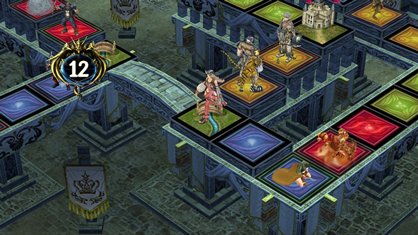GamesRadar+ Verdict
Pros
- +
Winning cards and compiling decks
- +
Pwning your friends
- +
Stealing cards online from noobs
Cons
- -
The first few maps
- -
When luck frowns upon you
- -
Rilara's busted-ass belly button
Why you can trust GamesRadar+
If you never got into the strategy card game Magic: The Gathering, you probably know a few people who did. They are the incorrigible type of bastards who lay siege over dorm rooms until the wee hours of the morning with their boxes and boxes of cards, snarfing up all your beer and pizza along the way. Playing through Culdcept Saga, which blends Magic's card-style combat with a Monopoly-esque board game, we can’t help but understand the draw to such a game. Put bluntly, there’s never been a more niche title that’s so easy to get into and so addictive, and yet so difficult to truly master.
You play as a boy who discovers he’s a Cepter: a person who can use the Culcept cards, which are parts of an ancient book. Honestly, the story’s fine but it's all folly-roll compared to the gameplay. After some text-heavy cutscenes, you jump into battle on maps very much like the tiled trails in any board game. Every round, you draw a card, which will be one of three types: creature, spell or item. You then cast a spell if you have the card and the desire to do so, "roll" the die and move the accompanying number of spaces around the board.
When you land, you can summon a creature to guard that spot. Unless someone else has a creature guarding it already, in which case you either pay a toll or call up your own monster to fight it. Then, a quick one-round fight comparing each card's attack against the other card's defense dictates who wins the square. This continues until one player obtains the target amount of magic points, which double as money, and gets back to the starting square.

It sounds simple, and it is. But, like all the best games, there are layers of strategy and nuance that hook you ever deeper into the game. The creatures have either one of four elemental attributes: Fire, Water, Earth and Wind, or are neutral or a mix of several elements. So is every square on the board. The elements coincide with the tiles on the board, which when combined with a like-elemented (yes, we made that up) creature yield a variety of chain bonuses. Put a Minotaur on a Fire Attribute Land territory and you’ll get +10 HP. If you position more of your monsters on adjacent squares, you get more multipliers. You getting all this?
More info
| Genre | Strategy |
| Description | This board game-turned-RPG is like the perfect blend of Monopoly and Magic: The Gathering, but with achievements. |
| Platform | "Xbox 360" |
| US censor rating | "Teen" |
| UK censor rating | "" |
| Release date | 1 January 1970 (US), 1 January 1970 (UK) |



